John Elder Robison's Blog, page 17
May 11, 2011
Dr. Liz Laugeson on How to Make Friends
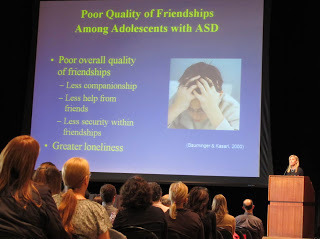
I've just come from a morning at the Parents/Families/Community
conference that's associated with the big IMFAR autism science meeting. The conference moves around every year
(some of the scientists have a reputation for getting wild) and this year we're
in San Diego. I flew in late last
night just in time to sleep three hours and get up bright and early for the cab
ride to the University of California at San Diego.
As long as I remain functional, I will be reporting on
events here and at the main conference for the next three days. In addition, I hope to visit the San
Diego container terminal and perhaps capture novel and exciting images of
shipping and transportation.
As much I love ships and trains, I recognized my commitment
to autism science and dutifully appeared where I was supposed to be, before I
was supposed to be there. I was
just in time for the keynote sessions, which I found totally fascinating.
The first talk I'd like to share with you concerned a
program called PEERS, which was developed by Liz Laugeson and Fred Frankel of
UCLA, and presented by Liz at this morning's session.
PEERS is a science-based program that helps kids make
friends. I say its science based
because she actually tested and proved out the various concepts in PEERS
through trials. By doing that, she
was able to quantify what worked and what didn't.
And that, folks, is a really important thing in the world of
therapy.
Most therapists who work with folks on the spectrum do not
have autism themselves. Therefore,
things that may seem obvious to them may be totally obscure to the folks they
are trying to help. Consider the
example of a teen who has trouble getting into conversations with strangers.
A person who does not have autism instinctively reads the
non verbal signals from people around him. He knows when to speak up and when to be quiet, and he knows
how to join a conversation smoothly.
At least, that's the idea.
A therapist who grew up with those skills naturally assumes everyone else
is similar. That being the case,
conversational skill is simply a matter of polishing one's skill.
Unfortunately, for most autistic people, "polishing" does
not work. We lack the ability to
read other people, so "watching and slipping in smoothly" is not something we
can do at all, without special training and a lot of practice. Yet that deficiency may not be at all apparent
to a nypical therapist, even after he's studied autism. Therefore, the advice that worked for
him may totally fail for us, and he may not have any idea why, except to say "we
just can't get it."
That's where science and evidence-based therapy development come
in. Researchers can try different
ways of helping people solve problems, and them measure how well that training
works in real life. By testing
different strategies, it becomes possible to separate what works from what
doesn't, and to refine what works well into what works better. That is what Drs Laugeson and Frankel
have done with PEERS.
I could cite example after example from the book, but
frankly, if you have a personal stake in helping people make friends, I urge
you to buy the workbook. It's
written to do group therapy for high school students but it's immediately
obvious to me that the concepts can be used for self-study and even for Asperger adults. I mentioned that to Dr. Laugeson and
she agreed but was quick to point out that the work had not been validated yet
in adults.
So if you're an adult Aspergian, or you know one . . .you
can be among the first to try these ideas out. Let me know what you think.
The PEERS workbook is in many ways a clinical version of my
Be Different book. In that book, I
talk about the strategies I've used to find success, and how I made the most of
my autistic gifts while minimizing my disability. What PEERS does is take those ideas to the next level.
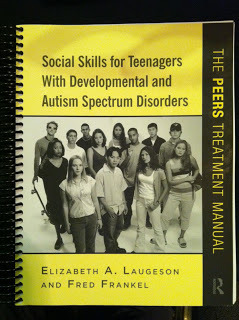
I wrote about making friends from the perspective of my own
success as a person with Asperger's.
PEERS approaches the same problem but from the perspective of many
young people with autism, not just me.
PEERS was developed with funding from the National Institutes
of Health. To me, it's a great
example of the kind of research we should encourage in the autism
community. This is work that will
be of tremendous benefit to many people growing up with autism now.
You can order her book here
Over the next few days, I'll be looking at all sorts of
research. I'll see work from
biologists, geneticists, psychologists, neurologists, and psychiatrists. I'll even be looking at studies from
public health people and statisticians.
Stay tuned as I report on highlights to come . . . after I visit the Container Terminal
John Elder Robison
(c) 2007-2011 John Elder Robison

May 9, 2011
New study finds Korean incidence of autism 1 in 38
I think autism is under-reported here in the US, but even I was surprised by the findings of this research.
Here is the official press release:
New York, N.Y. (May 9, 2011) – In the first comprehensive study of autism prevalence using a total population sample, an international team of investigators from the U.S., South Korea, and Canada estimated the prevalence of autism spectrum disorders (ASD) in South Korea to be 2.64%, or approximately 1 in 38 children, and concluded that autism prevalence estimates worldwide may increase when this approach is used to identify children with ASD. "Prevalence of Autism Spectrum Disorder in a Total Population Sample," published today online in the American Journal of Psychiatry reports on a study of all children (approximately 55,000) ages 7-12 years in a South Korean community, including those enrolled in special education and the disability registry, as well as all children enrolled in general education schools. Children were systematically assessed using multiple clinical evaluations.
The research by Young Shin Kim, M.D., M.S., M.P.H., Ph.D. of the Yale Child Study Center, and her collaborators Bennett L. Leventhal, M.D., Yun-Joo Koh, Ph.D., Eric Fombonne, M.D., Eugene Laska, Ph.D., Eun-Chung Lim, M.A., Keun-Ah Cheon, M.D., Ph.D., Soo-Jeong Kim, M.D., HyunKyung Lee, M.A., Dong-Ho Song, M.D. and Roy Richard Grinker, Ph.D. found more than two-thirds of ASD cases in the mainstream school population, unrecognized and untreated. "These findings suggest that ASD is under-diagnosed and under-reported and that rigorous screening and comprehensive population studies may be necessary to produce accurate ASD prevalence estimates," stated Autism Speaks Chief Science Officer Geraldine Dawson, Ph.D. "Autism Speaks funded this study to support better detection, assessment and services and to encourage international autism research."
According to Dr. Kim, experts disagree about the causes and significance of reported increases in ASD, partly because of variations in diagnostic criteria and incomplete epidemiologic studies that have limited the establishment of actual population-based rates. "We were able to find more children with ASD and describe the full spectrum of ASD clinical characteristics," said Dr. Kim. "Recent research reveals that part of the increase in reported ASD prevalence appears attributable to factors such as increased public awareness and broadening of diagnostic criteria. This study suggests that better case finding may actually account for an even larger increase. While the current project did not investigate potential risk factors in this particular population, the study does set the stage for ongoing work to examine genetic and environmental factors contributing to the risk of ASD."
This study is further evidence that autism transcends cultural, geographic, and ethnic boundaries and that autism is a major global public health concern, not limited to the Western world. To date, there is no evidence of differences in the way ASD is expressed in children around the world; however it is possible that cultural factors may impact diagnostic practices and prevalence estimates. As a result, the South Korean study took a comprehensive approach to mitigate potential cultural bias. According to Dr. Grinker, a cultural anthropologist at George Washington University, "Parent and teacher focus groups were conducted to identify local beliefs that might influence symptom reporting and to address stigma and misunderstandings related to ASD. Further, clinical diagnoses were established by Korean diagnosticians with extensive clinical and research experience in both the U.S. and Korea and were validated by North American experts."
The study does not suggest that Koreans have more autism than any other population in the world. What it does suggest is that autism is more common than previously thought and that, if researchers look carefully, especially in previously understudied, non-clinical populations, they may find more children with ASD. In addition to the South Korean study, Autism Speaks is supporting similar epidemiological research efforts in India, South Africa, Mexico, and Taiwan, including the translation and adaptation of the gold-standard diagnostic instruments into languages spoken by more than 1.7 billion people worldwide.
"This is the first comprehensive population sample-based prevalence calculation in Korea, and replication in other populations is essential," explained Dr. Dawson. "Notwithstanding the need for replication, this study provides important evidence that the application of validated, reliable and commonly accepted screening procedures and diagnostic criteria applied to a total population has the potential to yield an ASD prevalence exceeding previous estimates."
"We know that the best outcomes for children with ASD come from the earliest possible diagnosis and intervention," concluded Dr. Kim and her colleague Dr. Koh from the Korea Institute for Children's Social Development, "Goyang City, host of the Korea study, has courageously responded to these study findings by providing comprehensive assessment and intervention services for all first graders entering their school system. We hope that others will follow Goyang City's example so that any population based identification of children with ASD is accompanied by intervention services for those children and their families."
This research was funded by a Pilot Research Grant from Autism Speaks as well as grants from the Children's Brain Research Foundation, NIMH and the George Washington University Institute for Ethnographic Research.
(c) 2007-2011 John Elder Robison

May 5, 2011
A few new videos to share
I also stopped in at Google on that same speaking tour. I visited their Mountainview headquarters, outside of San Francisco, where I talked about life as a geek and fitting in. They've added that to their Authors At Google series, and you can watch it here
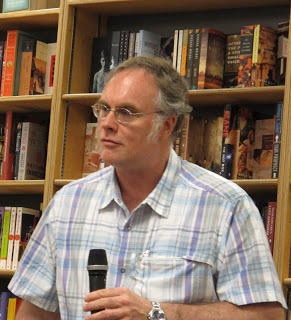
(c) 2007-2011 John Elder Robison

May 4, 2011
Men with Guns, and tales from the road . . .
My hosts put me up for the night at the Avenue Plaza hotel, a kosher establishment on the corner of 13th Avenue and 47th Street.
I went to bed early, and since it was a warm night, I left my fourth-floor windows open. Why not? I'd been assured that I was in a safe area, and I'd seen the Hebrew "neighborhood watch" signs on every business. The only folks on the street were Hasidim. They are distinctive in their black coats and hats and white shirts, and I'd always known them as peaceful. I'd never known them to attack or raise a ruckus.
They are a serious, conservative, quiet bunch. Knowing that, I went to bed expecting a calm night in the suburbs. But it wasn't meant to be . . . I was awakened at 11:30 by shouting and sirens. Looking out, I saw the intersection blocked with police cars and a mob of people. I grabbed a camera and flashlight, and headed out the door . . .

The hotel doorman had the answer. Two guys with guns tried to hold up the store over there. He called for help on his radio, and the community turned out. We're holding the guys for the police. He was a proud member of the Watch. The store keepers all have radios, and there are members everywhere in the community. When an emergency call goes out, they move fast. These guys didn't have a chance. Before they knew what hit them, the store was surrounded by serious looking men in suits, and they weren't going anywhere.
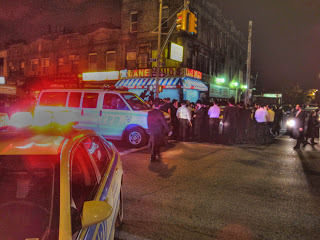
When I reached the intersection, I saw the cops had arrived but there was a huge crowd pressing up against the corner store.
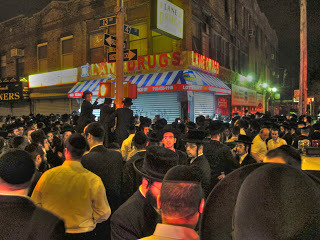
Moving closer, I found the mob had squashed the would-be robbers against the wall where they were arrested by the NYPD. I was impressed that a crowd of unarmed men faced down two guys with guns, and won. But where were they going to go? Six shots would not go very far against 400 people. They were peaceful as long as the crooks stayed surrendered, but if they started shooting, I'll bet they'd have torn them to bits.
The cops got them into the car, and the crowd reluctantly parted to let them leave.
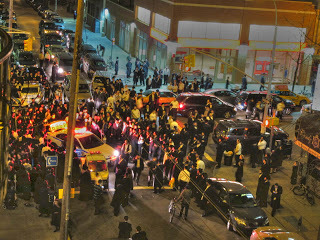
The next morning, it was as if it never happened . . .

This is a community that stands up for itself. I was impressed. I've seen a lot of "community watch" stickers over the years, but I never saw one with that was backed up with a crew like this . . .
(c) 2007-2011 John Elder Robison

April 26, 2011
Requiem for Phoebe

I came home to the sad news that singer Phoebe Snow had
died. I had not thought of her in
years, and she probably didn't think of me at all, but our paths crossed
thirty-some years ago, and the news of her death brought those memories back to
me tonight.
The year was 1977, and the show that's clear in my mind was in
the old Orpheum Theatre in Boston, Massachusetts. It must have been summer, because I'd driven there in my
blue Eldorado convertible with my brother. I wasn't traveling with the tour, but they had my sound equipment,
and I was in Boston to fine tune the crossovers, limiters, and equalizers. I was also swapping out some of the
amps; that tour used Phase Linear 700s, some of the least reliable but best
sounding amplifiers ever to do a rock and roll show . . .
Phoebe was two years from her debut album, Phoebe Snow. She had recorded another album, Second
Childhood with producer Phil Ramone, but it had not sold as well and she was
kind of struggling to find her way after changing musical directions and the
birth of her child. She was
touring the music from both albums, playing the "artsier" arrangements like No
Regrets and Isn't it a Shame, but the audience wanted the simplicity and beauty
of Poetry Man.
Dan Hill had just found the biggest hit of his career with
Sometimes When We Touch. That's
the only song of his that most people know, but he had other sweet melodies,
like You are All I See and Still Not Used To.
I watched the whole show from the alcove on stage left, next
to the monitor console. I stood at
the edge of the curtains looking out across the stage. I remember each of them singing, and
then the two of them together, at the end of the night. I wish I could remember what they sang
together.
I stood by the amplifiers, which sat on the floor with heavy
cables going forward to the speaker arrays on scaffolds to either side of the
stage. I watched the needles swing
in time to the music, never coming close to maximum power. I marveled at how little it took to fill a big hall with
simple vocals and instruments. I'd
had Black Sabbath in the same venue, a few months before, using ten times the
wattage from the same racks of equipment.
I liked shows like those, because I enjoyed the melodic
performances. I did a lot of heavy
rock and roll, but I always felt my ears and my gear took a beating, while
performances like Dan and Phoebe were comfortable and warm. And they were challenging . . . when
you have a simple show, with one vocal and one instrument (a piano or guitar)
ringing out, they must be clear, brilliant, and smooth.
I sometimes thought shows like these were the most challenging,
because the sheer volume and distortion at a loud heavy metal concert hid many
defects and errors; faults that were plain to hear at lower volume shows like
this one. The simpler the music,
the better it has to be delivered, to sound right.
I still think of them as solo performers, but both were
backed up by bands. However, the
bands were really in the background for the whole show. When I recall the night, I can't
remember the other musicians at all, though I remember the sounds of the piano
and the guitar, and of course we were using a 24-track mixing console with all the
channels filled so there had to be a other few musicians to feed it!
It's funny . . . I can remember every piece of equipment at
the show, and the car I drove there, and even the feel of the curtains behind
the stage. But I cannot for the life of me conjure up the faces of the
musicians.
I guess that's the Asperger's . . . I lived in a world of
machines, not people, and the gear was my world. I wonder if I'm still that way today . . . so much has
changed, but much is still the same; more than I know sometimes . . .
Best wishes to you all
Good night
PS: The photo I chose is not Dan Hill or Phoebe Snow; it's John Sebastian at a performance in 2008. I chose it because I felt it evoked the feeling of that night, so long ago.
(c) 2007-2011 John Elder Robison

April 10, 2011
A visit to Nashville in pictures
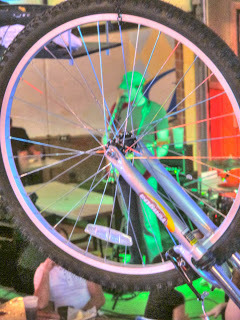
Upstairs at the Roof
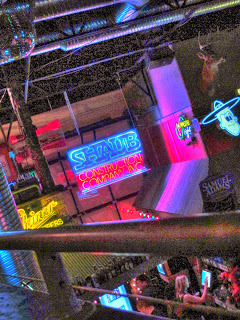
Outside
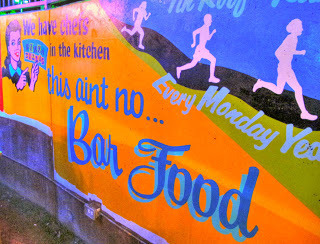
Backstage in a bar . . . I spent so many nights gazing out from that vantage point . .
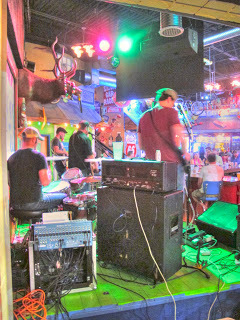
I don't know what you call this guy, but I found him in the window
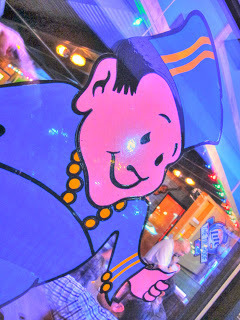
Dena Gassner, who runs the Nashville GRASP group and the Center for Understanding. She hosted me in Nashville at her conference.
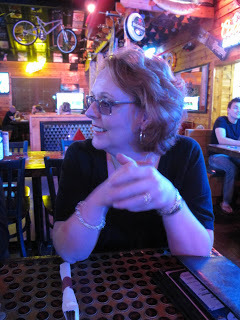
Dena's friend John, who knows where to go in Nashville
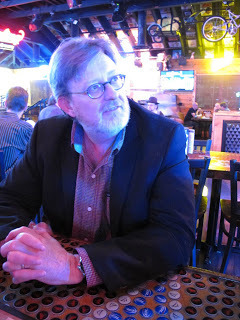
Playing bass
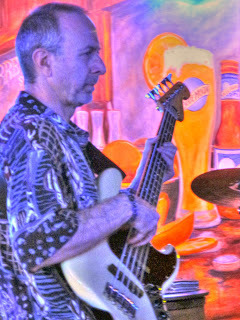
One of the buildings near the bookstore where I met folks Friday

A street scene in Nashville
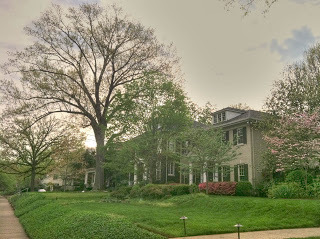
This is the front of the church where I spoke Saturday

And now we're back in the bar, with John on the right
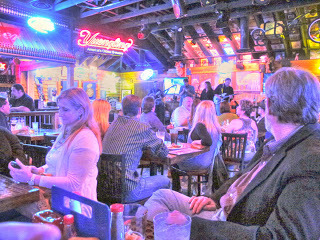
The town circle by night
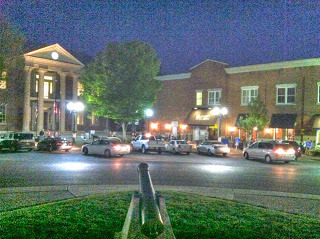
Landmark books, where I left some signed copies of my new book for anyone who missed the conference. Look Me in the Eye was all sold out.
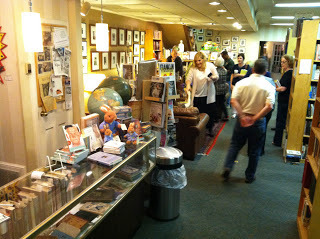
Budweiser
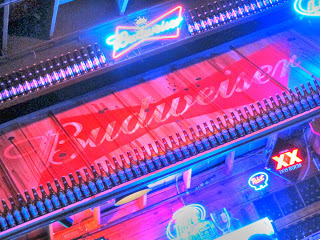
Now it's Sunday, and I'm a thousand miles away in Canada. Tuesday I speak at St Joe in Philadelphia, and then it's off to Colorado, for talks in Boulder and Denver.(c) 2007-2011 John Elder Robison

March 30, 2011
Scenes from the Be Different book tour







Join me today, March 30, at Elms College in Chicopee where I'll introduce my friend Kim Stagliano, who will tell us about her new book, All I can Handle. Tomorrow I hope to see some of you at Barnes and Noble in Framinghm, MA at 7PM. Then I'll be at Smith College in Northampton MA on Sunday.
My full schedule is here
(c) 2007-2011 John Elder Robison

March 24, 2011
Be Different is finally here

Be Different went on sale this Tuesday, and I'm on the road with a pretty grueling travel schedule to promote it. My first talk was at the Autism Society of America's Georgia conference, #ASAGA11 for those who tweet.
I've had a great reception there and from the Connecticut Society of Special Education Professionals, where I spoke Wednesday. Today, Thursday, I have the honor of speaking at the National Institutes of Health in Washington, DC.
So where do I go from here?
Sunday morning (March 27) and afternoon I am at the ASPEN Asperger conference at the Hilton Woodbridge Inn, in Iselin, New Jersey. The website says the conference is sold out but call them . . perhaps you can get in anyway.
Sunday evening I am in Manhattan for a GRASP event at 7PM, at 339 West 24th St, the site of the regular Manhattan GRASP meeting. Register for that here
Monday morning I'll be doing some radio shows . . . listen for me later that week on Sirius Doctor radio, and also live Monday with Brian Lehrer on New York Public Radio
Monday evening I'll be at Barnes and Noble Tribeca, 7PM
Wednesday March 30 I'll be at Elms College Library in Chicopee, MA introducing my friend Kim Stagliano who will be talking about her new book, All I Can Handle, a memoir of raising three daughters with fairly severe autism.
Thursday March 31 I hope to see some of my Boston area friends at Barnes and Noble Framingham, MA, at 7PM.
Stay tuned for more dates, as I visit more of the East, then hit Denver/Boulder, then the West coast. I'll be working in a few Canadian stops and some autism conferences, like Autism One this May.
Meanwhile, if you've read Be Different, please spread the word. Blog it, review it, and tell your friends. It's word of mouth that makes books like this a success, and for that, I need all of you.
Best wishesJohn
(c) 2007-2010 John Elder Robison

March 15, 2011
Some links to preview Be Different, in print and audio
If you'd like to hear me read the intro, with pictorial accompaniment, look here
I'm both incredibly excited and incredibly anxious . . . Be Different goes on sale in seven more days!
I'll be speaking in Atlanta on opening day, at the Georgia Autism Society of America conference. The following day, I'm speaking to the Connecticut Special Education folks in Hartford. You can get tickets to that here. On Thursday I'll be addressing the National Institutes of Health in Washington, DC.
After that I've got several months of travel in both the US and Canada. I'm looking forward to meeting more of my online friends in person this tour.
See you on the road!
(c) 2007-2010 John Elder Robison

March 14, 2011
Exceptional, or ordinary with practice?

How do you solve math problems in your head? Perhaps a better question is, do you solve math problems in your head? With the availability of electronic devices to do it for us, I would not be surprised to learn that many people never try.
I was reading Darold Treffert's book on savants, and I was intrigued by a few examples of savant thinking. I tried solving some of the problems in his book to get a feel for how "comprehensible" they might be to me, with no recent practice calculating. Here is a simple example:
You have a carriage with a wheel that's six yards in circumference. How many revolutions will the wheel make while traveling two hundred twenty miles?
This is how I answer that question in my head. I'd be interested in how you might do it:
Six yards is eighteen feet. I see that as a short line.
So one hundred revolutions of a six yard wheel would take me 1,800 feet. That's a much longer line in my head, one that curves.
Three hundred revolutions would take me 5,400 feet – more than a mile. Now the line has curved back unto itself, making a circle.
How many rotations are there to a mile? Less than three hundred. A mile is a smaller circle. I can see those circles, on inside the other. They do not quite match.
I adjust the length of the longer line that forms the big circle. Try 290 . . . that's 5,400 less 180, or 5,220. A mile is 5,280. Now I see the line laid flat, like a straight stretch of highway. Two hundred ninety revolutions leaves us sixty feet short of a mile marker. So what's the fraction?
Three eighteens go into that sixty-foot remainder with the same six remainder. Adding that to the 290, I see the answer is 293 and a third. The six-yard wheel does not fit a one mile line, but it fits perfectly into a three-mile ring. If you put a mark on the wagon wheel, and mark any point where it touches the big circle, those points will touch every time the wheel rolls past. I like that.
If you roll the same wheel around a one-mile ring the points will only touch every third trip around, which is unsettling to me. I like smooth fits, so I will solve the next step using three-mile units.
I can now see the answer: 880 revolutions. A perfect fit. Six yards, three miles, and eight hundred eighty turns.
How many three-mile eight-hundred-eighty revolution units are there in 220 miles? My mind visualizes stacks or piles for this next step. Seventy units reach two hundred ten miles. I quickly see how seventy-three and a third are needed to reach the two-twenty goal.
Stacking seventy-three piles of 880 in my mind takes a little time. Eventually, the stacks add up and I see the result is 64,240. Now I just have to add the third (of 880) and I'm done. To do that, I add three hundred to the pile, making 64,540, and then take back six and two-thirds.
64,533 and 1/3 is the answer to the question.
As a further experiment, I scaled up the distance, to 2450 miles and then 20,315 miles to see if I could keep scaling up the numbers. There must be some limit to that, and it certainly took me longer, but I solved those bigger problems in a few more minutes. Solving the longer distance problems involved one and then two more levels of "stacking" in my mind.
It does not seem that hard to me. I often did similar calculations as a kid, for fun. I'm sure I could do it again, pretty quickly, with some practice.
I test my answer with a calculator. The process to do that is considerably simpler.
I multiply 220 (miles) by 5,280 (feet per mile) to get 1,161,600 – the total distance in feet.
I divide that by 18 (the wheel circumference) to get 64,533.333 – the revolutions turned.
It's a lot faster to get this answer with a calculator, for sure. But is the ability to figure this out in one's head really exceptional? In today's world, I would not be surprised if kids never develop these skills. When I grew up, though, pocket calculators did not yet exist and I had to know how solve problems like this. I suspect many people of my generation could solve a problem like this in their heads, but perhaps I am wrong. What do you say?
(c) 2007-2010 John Elder Robison




